It’s a bit odd when you think about it, that despite coming from a home where Idlis are a breakfast staple, Idlis haven’t made it on the blog so far! Idlis, a typical South Indian dish that is popular all over the country, is the mainstay for breakfast in many a home in that part of the country.
Not very difficult to make so long as you have the batter sitting in the fridge, you can have Idlis cooked and on the table in under half an hour. Idlis are wholesome, filling and healthy because they’re steam cooked. They’re also vegan and gluten-free, and make for a very balanced meal when served with any variety of Sambhar (vegetables and lentils in a tamarind based gravy).
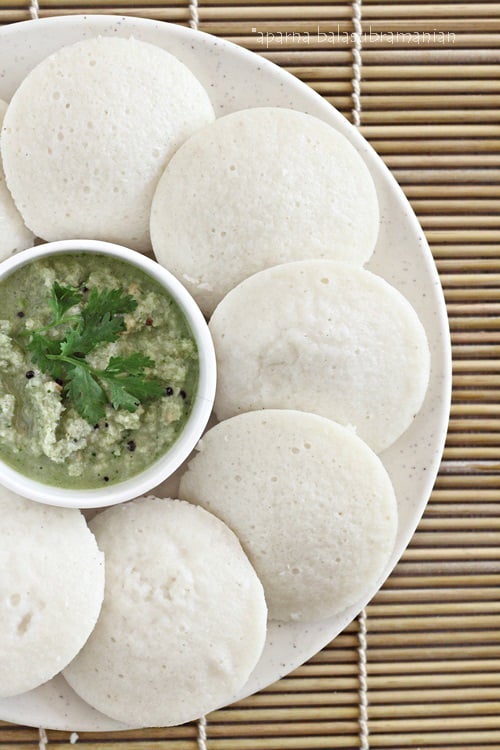
If you’re new to Idlis, they’re soft and fluffy steam cooked savoury rice and lentil cakes that are usually eaten for breakfast in South India. Typical accompaniments are Sambhar (vegetable and lentils in a tamarind sauce), Coconut Chutney and Milagapodi (a dry lentil chutney powder) with oil. You can serve Idlis with all three accompaniments, any two or one of them depending on what you have the time for. You would find “Medhu Vadas” (crisp lentil doughnut like fritters) also being served alongside in restaurants but this is not common practice in the average South Indian homes because we rarely start our days with deep fried food.
A true blue idli should be a pillowy soft little round of goodness. One would think this was easy enough to achieve and it can be, provided one has managed to find the right ratio of rice and lentils that go into it, a good variety of rice, split black gram lentils of good quality and the perfect recipe. There are also some other things to keep in mind or do to ensure you get soft Idlis every time, and as they say, “practice makes perfect”.
I always thought that Idlis were a South Indian invention because think South Indian food and Idlis will definitely come to mind. However there seems to be some some discussion about the origin of the Idli. So some Kannada literature from 920AD mentions something called “Iddalige”, Sanskrit literature from 1130 AD mentions “Iddarika”, it is only in the 17th century that Tamil literature mentions the “Itali”! Some claim that the Idli is Gujarati in origin because they used to make something called “Idada” from the same ingredients and in the same way and was probably brought to the South in the 10th or 12th century slik weavers from Saurashtra. Then there are eferences available at the Al-Azhar University Library in Cairo suggesting the Idli came with Arab traders when they came to the South, married and settled down there. According K T Achaya, the Idli could possibly have been adopted from Indonesia where they had something similar called Kedli though I couldn’t find any mentions or recipe for this on the net! All I know is that the Idli is now as South Indian as I am!
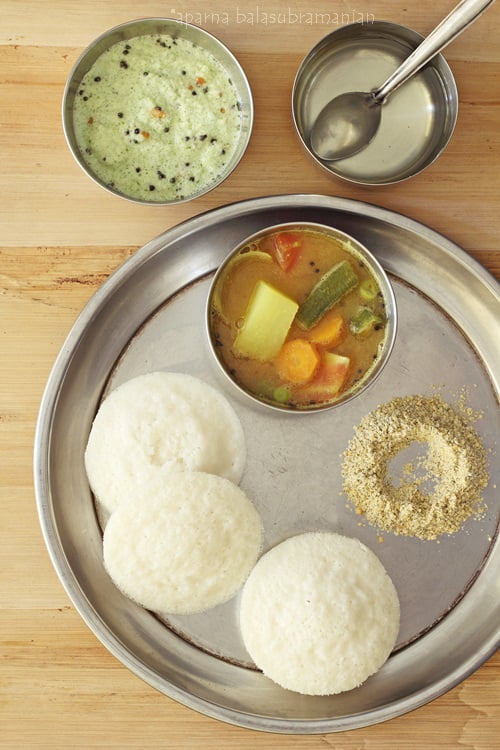
In the good old days when our grandmothers ruled the kitchen, batter for Idlis (and whatever else it was needed for) was ground in an “aatukallu” (literally translates as grinding stone). It was hard work and and the grindstone could grind only a little rice or lentils at a time. A whole lot of grinding had to be done to feed everyone in the large extended families of those days!
Thankfully, technological progress has meant the arrival of the table top wet grinder or the more used mixer/ grinder so Idli batter is much easier to make today. If it’s available where you live you could always buy ready-to-use batter, but it will never come close to the home made version. There is no one perfect Idli recipe and most families who make them regularly will swear by their own methods. The recipe here is what works for me, and you could try it out and see if it works for you too.
The texture of Idlis depends on a lot of variables like the quality of the rice, the lentils, how you grind it, how long you ferment the batter, the consistency of the batter, how long the batter has been stored, etc. My mother used to use a mix of raw (unprocessed) rice, boiled rice and lentils to make her Idli batter, and that was my go to recipe for a long time. Then I discovered a variety of boiled rice in Kerala called “Idli Rice” which makes the best Idlis I’ve eaten. The “Sona Masuri” variety of rice (unsteamed), a medium grain rice, is a good substitute if you can’t find Idli rice.
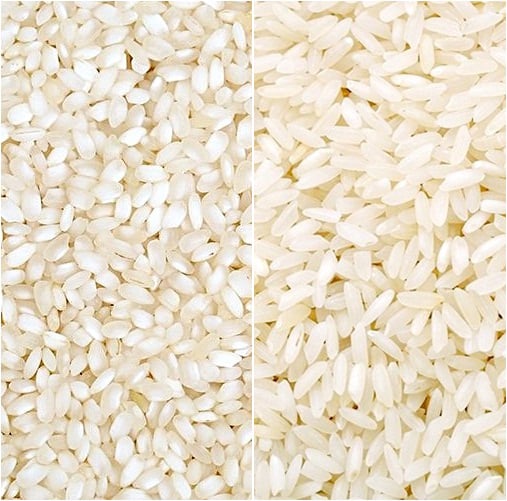
Use plumper looking split lentils and if you can find whole de-husked black gram lentils then use that because it makes for a fluffier batter for some reason. At home we add a little fenugreek seeds to the rice while soaking it. Fenugreek has medicinal properties, is healthy and also makes softer Idlis. You could also add a small handful beaten rice flakes (aval or poha) while grinding the batter for added softness. Some people add a handful of cooked rice instead but this practice is not considered kosher according to our religious traditions if one is particular about that.
The proportion of rice to the lentils to be used for Idlis is a matter of much debate among Idli makers. If grinding the batter in the mixer/ grinder, I would use a 3 : 1 proportion of rice to lentils and a 6 : 1 ratio if using the wet grinder.
The wet grinder has granite grinding stones and the motor works at a much slower speed so the batter does not heat up and this is more desirable for fermentation of the batter. If you grind the batter in the mixer/ grinder, it heats up the batter a bit because the motor works at high speed. This heat production can be counteracted by using chilled/ ice cold water to grind the batter.
Once the batter has been ground, then it has to be left at room temperature to ferment. This can take from 8 to 12 hours depending on the ambient room temperature in the tropical Indian climate. It would take even longer in colder climates. In such cases, you can speed up the fermentation by placing the batter in a barely warm oven. Then the batter can be refrigerated till required. Do use up the batter in a couple of days because it will become sour and not make good Idlis. Sour Idli batter doesn’t have to be discarded as it can used to make things like Uthappam (pancakes with onions and tomatoes) or Paniyaaram (Indian style savoury Aebelskivers) or Aapams.
This batter can also be used to make Dosas, which are savoury crepes. Dilute the batter a bit with water to a thinner consistency. This will make for thin and crisp Dosas pan cooked with a little oil, but that’s for another post to come soon.
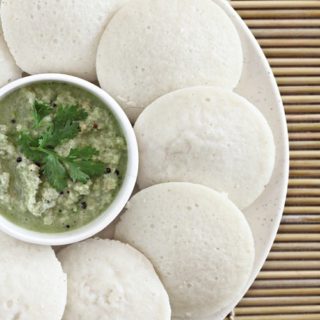
Idlis – South Indian Steamed Savoury Rice & Lentil Cakes
Ingredients
- 3 cups Rice Sona Masuri rice Idli or
- 1 cup black gram lentils split (urad)
- 1 tsp fenugreek seeds
- Salt (to taste)
- grease Oil to Idli moulds
Instructions
- First the batter has to be made. Soak the rice and the fenugreek seeds together in water for at least about 5 to 6 hours. Soak the lentils separately in water for about 2 to 3 hours. You can do this sometime in the afternoon, do the grinding sometime before you turn in and let the batter ferment overnight. Otherwise, soak the rice last thing at night before you turn in and then soak the lentils first thing in the morning (youu2019ll need to get up early). Then grind the batter and let it ferment during the day.
- First grind the lentils. Drain the lentils and discard the water. Put them into the wet grinder/ processor/ mixer jar and add about a half cup of water initially, adding more when necessary (you might need up to another cup depending upon the quality of the lentils), and grind it to a smooth, fine and fluffy batter. Transfer this batter to a large container. Your container should be large enough that the rice and lentil batter together fills only about half of it as the batter requires room to rise to about double as it ferments.
- Next drain the rice and fenugreek seeds, and discard the water. You neednu2019t wash out the jar/ bowl of your grinding machine. Add the rice to it and enough water (about a cup or so), adding more when needed, and grind it to a smooth and fine batter. You will find a very fine grainy feeling if you touch the batter. The batter shouldnu2019t be too thick or too watery, but err towards a slightly thicker batter. If you are using a processor or mixer/ grinder then use chilled water to grind your batters so that the motor doesnu2019t transfer its heat to the batter.
- Transfer this batter also to the container, then add salt to taste (ideally lightly salted), and mix the two batters together very well. Loosely cover, and let it ferment for about 8 hours or till it rises double in volume. Refrigerate the batter until needed.

- To make the Idlis, you need a set of Idli moulds/ plates. If you don't have them, you could use small bowls or even silicon muffin moulds (a mould that will withstand steam cooking like). My good friend sometimes makes them in fun moulds and even ice trays to pack for her childrens' lunch boxes!
- Keep you steam cooker ready. Lightly grease the Idli plates/ moulds with oil. Using a ladle, lightly stir to mix well (vigourous stirring will deflate the batter) and then pour ladles of batter into each well on the plates/ moulds till almost full. Make as many Idlis as you want and refrigerate the remaining batter for later use.
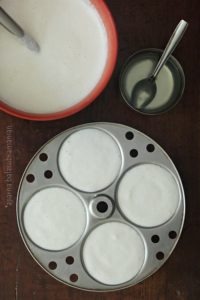
- Once the water in the steamer is boiling, place the plates/ moulds with the batter in, cover and let it steam cook for about 10 to 15 minutes. Over steaming can make the Idlis less soft. Take the plates/ moulds out and let them cool a bit, for about 10 to 15 minutes. Run the edge of a butter knife or spatula around each Idli and loosen it (it will not loosen neatly if it is still very hot). Unmould and transfer to a serving dish. Serve the Idlis slightly warm, with Sambar, Coconut Chutney or Milagaipodi (chutney powder).

I learn more things about the south Indian foods. Especially the morning breakfast food item. Breakfast is more important to maintain our body health. Thanks for your great post. http://www.angelmeds.com/blog/nutritious-breakfast-is-highly-important.html